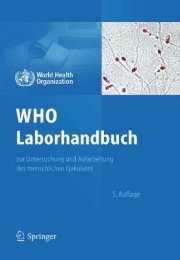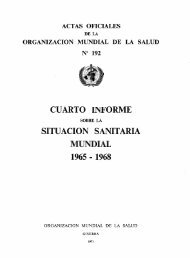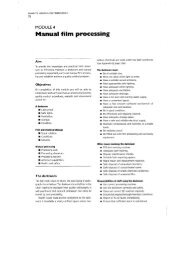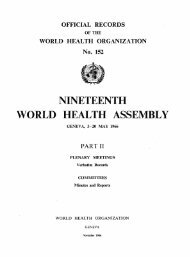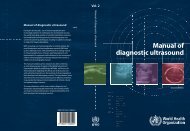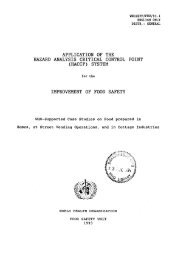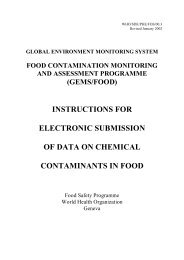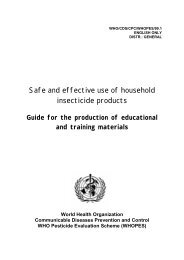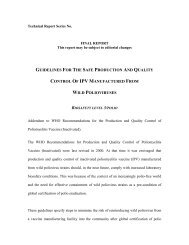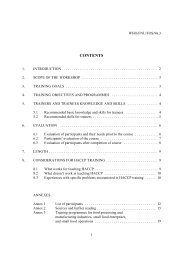CX/FAC 99/21 - World Health Organization
CX/FAC 99/21 - World Health Organization
CX/FAC 99/21 - World Health Organization
Create successful ePaper yourself
Turn your PDF publications into a flip-book with our unique Google optimized e-Paper software.
codex alimentarius commission<br />
FOOD AND AGRICULTURE WORLD HEALTH<br />
ORGANIZATION ORGANIZATION<br />
OF THE UNITED NATIONS<br />
JOINT OFFICE: Via delle Terme di Caracalla 00100 ROME Tel.: 57051 Telex:625852-625853 FAO I E-mail:Codex@fao.org Facsimile: +39 0657054593<br />
Agenda Item 15(d) <strong>CX</strong>/<strong>FAC</strong> <strong>99</strong>/<strong>21</strong><br />
December 1<strong>99</strong>8<br />
JOINT FAO/WHO FOOD STANDARDS PROGRAMME<br />
CODEX COMMITTEE ON FOOD ADDITIVES AND CONTAMINANTS<br />
Thirty-first Session<br />
The Hague, The Netherlands, 22-26 March 1<strong>99</strong>9<br />
DISCUSSION PAPER ON CADMIUM<br />
(Prepared by Denmark)<br />
REQUEST FOR COMMENTS AND INFORMATION<br />
Governments and interested international organizations wishing to submit comments<br />
on the following Position Paper on Cadmium are invited to do so no later than 15<br />
January 1<strong>99</strong>9 as follows: Ms. S.P.J. Hagenstein, Netherlands Codex Contact Point,<br />
Ministry of Agriculture, Nature Management and Fisheries, P.O. Box 20401, 2500<br />
EK The Hague, The Netherlands (Telefax: +31 70 378.6141; E-mail:<br />
s.p.j.hagenstein@mkg.agro.nl), with a copy to the Chief, Joint FAO/WHO Food<br />
Standards Programme, FAO, Via delle Terme di Caracalla, 00100 Rome, Italy.<br />
INTRODUCTION<br />
1. The 30 th Session of the Codex Committee on Food Additives and Contaminants (CC<strong>FAC</strong>)<br />
accepted the offer of Denmark to revise the Discussion Paper on Cadmium (<strong>CX</strong>/<strong>FAC</strong> 98/22) for<br />
circulation, comment and consideration at its current meeting (ALINORM <strong>99</strong>/12, paras. 98-100).<br />
This paper was based upon previous work of the CC<strong>FAC</strong>, including Draft Guideline Levels for<br />
Cadmium and Lead in Cereals, Pulses and Legumes (<strong>CX</strong>/<strong>FAC</strong> 97/20) as well as government<br />
comments received on cadmium as a contaminant (<strong>CX</strong>/<strong>FAC</strong> 97/22).<br />
2. In 1<strong>99</strong>5, France presented to the 27 th CC<strong>FAC</strong> a "Position Paper on Cadmium" (<strong>CX</strong>/<strong>FAC</strong><br />
95/19). This paper contained a review of relevant information on cadmium as a contaminant in<br />
foodstuffs, compiled as agreed in the General Standard on Contaminants and Toxins in Food<br />
(GSCT). This position paper recommended a number of measures, including<br />
• the CC<strong>FAC</strong> should propose international limits for cadmium in foods;<br />
• that a number of general measures are taken to reduce the cadmium contamination of foods; and<br />
• that some specific measures are taken with respect to food production, processing and storage.<br />
The CC<strong>FAC</strong> agreed to include the recommendations in the Draft Code of Practice on Source<br />
Related Measures to Reduce Contamination of Foodstuffs (<strong>CX</strong>/<strong>FAC</strong> 96/20 and <strong>CX</strong>/<strong>FAC</strong> 98/20), and<br />
to request more information.
2<br />
3. Following the request for more information, data were received on the content of cadmium<br />
in some foodstuffs and subsequently discussed at the 28 th , 29 th and 30 th CC<strong>FAC</strong>. A large compilation<br />
of data on exposure in Europe was published by the European Commission, Scientific Committee for<br />
Food (SCOOP 1<strong>99</strong>6). The 28 th CC<strong>FAC</strong>, moreover, noted that the CCCPL had been adjourned sine<br />
die and, consequently, the CC<strong>FAC</strong> was responsible for the proposed draft maximum limit for<br />
cadmium in cereals, pulses and legumes, retained at step 7 of the stepwise procedure.<br />
This paper provides:<br />
• a short resume of the toxicological evaluation of cadmium, as presented in the "Position paper on<br />
Cadmium", presented by France to the 27 th CC<strong>FAC</strong> (<strong>CX</strong>/<strong>FAC</strong> 95/19);<br />
• a revised overview of recent data on the content of cadmium as a contaminant in food; and<br />
• a revised set of Draft Maximum Levels for Cadmium in the foodstuffs that contribute most<br />
cadmium intake via the diet, or that have given rise to problems in international trade.<br />
4. Cadmium present in soil, even in small quantities, moves readily into the plant, which is in<br />
contrast to other toxic elements like lead. Vegetables and cereals are therefore generally known as<br />
the most significant sources of cadmium in the diet. Atmospheric fall-out will contribute to the<br />
content of cadmium, especially for leafy vegetables and grain. Cadmium accumulates in particular in<br />
the kidney and liver of animals, hence offal is a source of cadmium in the diet. Horses that are often<br />
slaughtered at a comparatively late age will contain much more cadmium than pigs and poultry,<br />
which are slaughtered at a younger age. Fish contain normally only small amounts of cadmium,<br />
whereas crustaceans and molluscs, being filterfeeders, may absorb larger amounts of cadmium from<br />
their environment. The release of cadmium from food contact materials such as ceramics, alloys and<br />
plastics may also contribute to the intake until such sources are eliminated.<br />
5. Additional to the dietary intake of cadmium, smokers may absorb large amounts of cadmium<br />
through the lungs, as the tobacco plant accumulates cadmium in the leaves, and some people may<br />
occupationally be exposed to cadmium. These aspects are further discussed in the position paper<br />
(<strong>CX</strong>/<strong>FAC</strong> 95/19).<br />
6. Though there are indications that source-directed measures to reduce cadmium<br />
contamination of the food chain show some effect, the ongoing pollution of the environment with<br />
cadmium is an important reason to take further action.<br />
A SHORT RESUME OF CADMIUM TOXICOLOGY<br />
7. Cadmium was last assessed by the JECFA at its 41 st Meeting in 1<strong>99</strong>3. The Committee<br />
retained the Provisionally Tolerable Weekly Intake (PTWI) of 7 μg/kg body weight, as expressed by<br />
the 33 rd JECFA, pending further research, and reiterated the statement made previously that "there is<br />
only a relatively small safety margin between exposure in the normal diet and exposure that produces<br />
deleterious effects." Cadmium has an extremely long biological half-life in humans and is<br />
accumulated in body tissues, particularly in the liver and kidney. Cadmium is nephrotoxic and may<br />
produce renal tubular dysfunction, characterised by increased excretion of proteins.<br />
8. Since the 1<strong>99</strong>3 JECFA assessment the International Agency for the Research on Cancer,<br />
IARC, had classified cadmium and cadmium salts in group I, as substances carcinogenic to humans,<br />
based on evidence from human studies, mainly those of lung cancer associated with cadmium<br />
inhalation in the work place, and from animal studies. The IARC classification is qualitative only.<br />
The Council of Europe has published a review "Cadmium in Food", mainly discussing the toxicology<br />
of cadmium (Council of Europe, 1<strong>99</strong>5). This and other new information will be discussed when the<br />
JECFA in 2000 is scheduled to evaluate cadmium again.
CADMIUM AS CONTAMINANT IN THE MOST IMPORTANT FOODSTUFFS<br />
3<br />
9. There are a number of fairly recent studies estimating the average daily intake of cadmium<br />
from foods from approximately 10 to 50 μg in areas without intense anthropogenic activity<br />
(UNEP/FAO/WHO 1<strong>99</strong>2; 41 st JECFA 1<strong>99</strong>3; SCOOP 1<strong>99</strong>6). This corresponds well with the results<br />
of the conservative estimates given in table 1.<br />
10. These studies agree that for the average consumer, largely the most significant sources of<br />
cadmium in the diet are cereals and vegetables, including potatoes. Meat and especially liver and<br />
kidney follow in importance (UNEP/FAO/WHO 1<strong>99</strong>2; 41 st JECFA 1<strong>99</strong>3; SCOOP 1<strong>99</strong>6). The foods<br />
mentioned cover more than 80% of the intake of the normal consumer. Molluscs and crustaceans<br />
constitute only a small part of the diet, so these commodities do not contribute much to the cadmium<br />
intake for the average consumer, though both products may contain high levels of cadmium. There<br />
are, however, indications that single exposures of high levels may result in a more efficient uptake of<br />
cadmium, possibly making such products more important, even though the consumption is irregular.<br />
Fish, too, contain small quantities of cadmium. The contribution from other foods are generally<br />
found to be negligible, unless accidentally contaminated.<br />
11. The concentration levels found in most vegetables, including bulbs, roots and tubers, are<br />
normally well below 0.050 mg/kg, whereas slightly higher average levels may be found in leafy<br />
vegetables such as spinach. Some wild mushrooms may contain high levels of cadmium, even when<br />
they have grown in uncontaminated soil. The cadmium may, however, be bound chemically, so that<br />
the bioavailability and thus the toxicity may be limited (ref. 1). This needs further investigation.<br />
12. Oilseeds, like sunflower seeds and linseeds, accumulate cadmium from the soil so that the<br />
content in the seeds may well exceed 0.5 mg/kg (SCOOP 1<strong>99</strong>6; ref. 2 - 5) independent of the<br />
concentration in the soil, and the same applies to cocoa beans (SCOOP 1<strong>99</strong>6; ref. 6).<br />
13. The levels of cadmium found in fruit are low, in the parts per billion range, and often below<br />
or close to the limit of determination of the commonly used analytical methods (SCOOP 1<strong>99</strong>6). Thus<br />
fruit is only a minor contributor to the intake of cadmium.<br />
14. Cereals are the other main source of cadmium in the diet. The cadmium is found mainly in the<br />
outer parts of the grain, wholly or partly removed in the milling processes, so the levels of cadmium<br />
found in flour or bread are lower than the levels found in grain. Wholemeal bread types contain more<br />
cadmium than other types, though the average content in bread rarely exceeds 0.1 mg/kg. Wheat, in<br />
particular durum wheat, may contain somewhat higher levels of cadmium (ref. 7).<br />
Rice will most frequently contain less than 0.1 mg/kg cadmium. Japan previously reported<br />
substantially higher levels, but later investigations have shown a decrease, and in a recent Japanese<br />
survey only 23% of the samples exceeded this level (IPCS EHC 134; <strong>CX</strong>/<strong>FAC</strong> 97/22). Moreover,<br />
the cadmium in some cereals may be chemically bound, so that the bioavailability is limited. This,<br />
however, needs to be further investigated. There is a draft guideline level of 0.1 mg/kg for cadmium<br />
in cereals, pulses and legumes at step 7, coming from the CCCPL, for consideration of the CC<strong>FAC</strong>.<br />
15. Meat of cattle, pig and poultry as well as sheep may contain cadmium as a consequence of a<br />
cadmium content in fodder and feedingstuffs. The levels in meat from muscle are in the order of 0.01<br />
mg/kg for the animals as normally slaughtered (ref. 8).<br />
16. Horse-meat in particular from old horses may, however, often contain substantially higher<br />
levels of cadmium. Mean contents exceeding 2 mg/kg have been reported, but it is not always clear<br />
whether such concentrations apply to meat or offal. Such contents are to be expected, as a
4<br />
consequence of their diet and lifespan. On the other hand, mean levels well below 0.5 mg/kg are<br />
reported from several countries (SCOOP, 1<strong>99</strong>6). Most consumers world-wide eat horsemeat only<br />
rarely and in limited quantities, but there are consumers who eat horse-meat products in quantities<br />
comparable to other meat types. There have been problems recorded in the trade of horse-meat<br />
because of the cadmium content.<br />
17. The content of cadmium in liver and especially kidney, is substantially higher than in the<br />
animal muscle. In liver of calf, pig and poultry, which is most frequently consumed, the levels<br />
normally found range from 0.02 to 0.2 mg/kg. Higher levels of cadmium may again be found in liver<br />
from older animals.<br />
As cadmium accumulates in the animal kidney bound to metallothioneines, this organ may contain<br />
rather high levels of cadmium. The cadmium levels generally found in kidney from calf and pig<br />
normally range from 0.05 to 0.5 mg/kg, whereas the content in bovine kidney may approach 1<br />
mg/kg. Kidney and liver from horse (if at all considered a food) may exceed 10 mg/kg, and should be<br />
avoided, or only eaten rarely.<br />
18. Fish will normally not be a major source to cadmium. The contents reported are generally<br />
low, in the parts per billion range. Contents reported are most frequently in the order of 0.02 mg/kg,<br />
though higher levels are occasionally found in some species or in fish from contaminated waters and<br />
sediments (SCOOP 1<strong>99</strong>6; ref. 9).<br />
19. Crustaceans, especially crabs, and some bivalve molluscs may contain substantial amounts of<br />
cadmium. The "brown meat" of the crab which is normally removed before consumption may<br />
accumulate more than 10 mg/kg cadmium (MAFF, 1983). Bivalve molluscs will normally contain<br />
perhaps 0.2 mg/kg cadmium, but as the molluscs may accumulate cadmium from contaminated<br />
waters by filtration, the contents found are sometimes considerably higher.<br />
20. In other foods, unless incidentally contaminated, the average cadmium content will be<br />
negligible and will not contribute significantly to the intake.<br />
<strong>21</strong>. The content of cadmium in food, as reflected in intake estimates, appears to decrease only<br />
slowly or to remain constant within the uncertainty of surveys from recent years (Council of Europe<br />
1<strong>99</strong>5; Danish VFA 1<strong>99</strong>5 and 1<strong>99</strong>9). Source-directed measures like those recommended in the<br />
"Position Paper on Cadmium" (<strong>CX</strong>/<strong>FAC</strong> 95/19) and the Draft Code of Practice for Source-related<br />
Measures (<strong>CX</strong>/<strong>FAC</strong> 96/20 and <strong>CX</strong>/<strong>FAC</strong> 98/20) will certainly have an impact on lowering the<br />
environmental burden. However, these measures still await full implementation.<br />
INTAKE CONSIDERATIONS<br />
22. The dietary intake of cadmium for many countries world-wide is presented by surveys from<br />
UNEP (UNEP/FAO/WHO, 1<strong>99</strong>2) and also by the SCF (SCOOP, 1<strong>99</strong>6) and others, see table 2. The<br />
methods of estimation used are different and they are reported in the original papers. The average<br />
intake is approximately 10 to 50 μg/day in areas of normal exposure, but may be higher in certain<br />
countries (ICPS EHC 134, 1<strong>99</strong>2). These figures, providing documentation for the statement<br />
concerning the small safety margin between exposure from the normal diet and exposure that<br />
produces deleterious effects, confirm the reason for taking action to reduce the exposure to cadmium<br />
from the diet, both for the average consumer and even more so for those who are particularly<br />
exposed because of local contamination, particular dietary habits or because they are additionally<br />
exposed as tobacco smokers or occupationally.<br />
23. JECFA in 1<strong>99</strong>3 expressed concern about having to use retrospective data for estimating the
5<br />
intake of cadmium from rice. Moreover the Committee acknowledged the need for research in areas<br />
recommended in the WHO ICPS Environmental <strong>Health</strong> Criteria 134 (ICPS EHC 134, 1<strong>99</strong>2) and<br />
highlighted some topics including examination of data on cadmium intake in various countries, data<br />
on cadmium content in foods and also studies on the chemical identity (speciation) and bioavailability<br />
of cadmium in foods (ref. 10). Since then there are more recent data available showing a lower<br />
consumption of rice for rural inhabitants in Japan, as well as a decrease of the content of cadmium in<br />
rice (<strong>CX</strong>/<strong>FAC</strong> 97/22; Council of Europe 1<strong>99</strong>5).<br />
24. There have been reports indicating a decrease in intake of cadmium from food in recent<br />
years, probably because of source-directed action showing some effect. Eliminating cadmium from<br />
food contact materials made of ceramics and plastics and reducing cadmium in waste by recycling<br />
electric batteries, should contribute to a decrease in intake, though other activities such as spreading<br />
of sewage sludge on soil used for cultivating crops for consumption may have an opposite effect.<br />
Improvements in analytical quality assurance in recent years may, however, also contribute to this<br />
effect by providing more accurate data on low levels of cadmium in food. However, even rather<br />
recent data often lack documentation of analytical quality control, hence making use of the data<br />
problematic.<br />
25. For the extreme consumer an "extreme daily exposure" may be estimated as well. As a rough<br />
estimate, this may conventionally be done by multiplying the typical exposure by three, giving 69 μg<br />
(table 1). Another approach was presented by the UK (<strong>CX</strong>/<strong>FAC</strong> 98/13), taking the 97.5% fractile<br />
from the two food groups contributing most to the exposure (for cadmium: cereals and vegetables)<br />
plus the average of the others as an expression of the intake by a high level consumer. This method<br />
of calculation gives be 52μg. In the most recent Danish study (VFA 1<strong>99</strong>9), the average daily intake<br />
was found to be 17 μg and the 95% and <strong>99</strong>% fractile were 28 μg and 35 μg , respectively. All<br />
estimates correspond well with the data in table 2. For vulnerable groups, particularly exposed to<br />
cadmium, such as vegetarians or people who eat large amounts of mussels or horse-meat, the<br />
exposure may be calculated, too, from national consumption data and the content of cadmium in the<br />
relevant foods. Concern with respect to the intake of cadmium for consumers with extreme eating<br />
habits, nationally regionally or otherwise, can probably best be addressed by relevant advice from<br />
national authorities.<br />
26. A Theoretical Maximum Daily Intake (TMDI) calculation analogous to that used in<br />
connection with the calculation of the theoretical intake of pesticides has been performed (table 1). A<br />
calculation using the typical intake figures and the limits proposed results in a TMDI of 52 μg<br />
cadmium, to be compared to a tolerable intake for a 70 kg person of 70 μg (or 60 μg for a 60 kg<br />
person), calculated from the JECFA PTWI. Whereas this calculation is theoretical, and may be called<br />
philosophical, it illustrates that the figures proposed for ML's theoretically do not completely cover<br />
the average consumer. (Reduced ML's for vegetables and meat might resolve this problem).<br />
HEALTH PROBLEMS<br />
27. The "extreme daily exposure" calculated as three times the average exposure, exceeds the<br />
JECFA tolerable daily or rather weekly intake. So does the exposure for those consumers who<br />
frequently eat large amounts of mussels, or possibly horse-meat. Consumers living in areas that have<br />
been particularly contaminated by industry may also fall into this category. For smokers, there is an<br />
additional significant contribution to the exposure. Until another JECFA assessment becomes<br />
available, the situation may probably best be described by the 33 rd JECFA statement that "there is<br />
only a relatively small safety margin between exposure in the normal diet and exposure that produces<br />
deleterious effects."<br />
POTENTIAL TRADE PROBLEMS
6<br />
28. There are national maximum limits for cadmium in food in many countries, potentially<br />
creating trade barriers. Problems in trade have occasionally been noted, most recently regarding<br />
horse-meat.<br />
TECHNOLOGICAL POSSIBILITIES<br />
29. As cadmium in food to a considerable degree is due to the technological use of cadmium,<br />
there are certainly possibilities to reduce the exposure by source-directed measures. Cadmium has<br />
already been removed or substituted in a number of food contact materials, and efforts to reduce the<br />
concentration of cadmium in sewage sludge and in phosphate fertilisers are underway. Such<br />
purification or substitution efforts, however, are sometimes difficult, as they may be costly. Other<br />
effective measures include e.g. the collection of cadmium containing electric equipment and batteries,<br />
so that they do not form part of waste to be incinerated, thus reducing the concentration of cadmium<br />
in atmospheric downfall.<br />
RECOMMENDATIONS<br />
30. The recommendations of the Position Paper on Cadmium (<strong>CX</strong>/<strong>FAC</strong> 95/19) to combat the<br />
contamination of food by cadmium by both general management of the use of cadmium in society<br />
and more specific measures related to the use in connection with food production should be followed<br />
and reviewed from time to time. Source-directed measures to reduce the content of cadmium in the<br />
diet are an essential part of a long term strategy to reduce this problem.<br />
31. Further research, such as recommended by the WHO (ICPS EHC 134, 1<strong>99</strong>2) and by JECFA<br />
(41 st Report JECFA, 1<strong>99</strong>3) is another cornerstone of a long term strategy to reduce the cadmium<br />
problem. This applies both to the toxicology, where some progress has been made in recent years,<br />
and also in areas such as chemical identity and bioavailability of cadmium species, present in food.<br />
32. The Position Paper on Cadmium also recommends that international limits for cadmium in<br />
certain foods are laid down, in accordance with the Codex General Standard for Contaminants and<br />
Toxins in Food. In table 1 there is a draft proposal for Codex ML's, as well as a general overview of<br />
the content of cadmium in various foods covering all foods giving a substantial contribution to the<br />
daily intake of cadmium for the average consumer. The Codex stepwise procedure to establish ML's<br />
is a thorough and also sometimes lengthy procedure, so a first discussion of ML's appears<br />
appropriate at this stage.<br />
33. The JECFA is scheduled to review cadmium again in 1<strong>99</strong>9. This review may well provide<br />
information essential to any discussion of cadmium in food, and particularly to the Codex discussion<br />
and decisions and to this paper. The CC<strong>FAC</strong> discussion based upon this paper should consequently<br />
be brought to a conclusion only when the results of the JECFA reevaluation of cadmium is available<br />
to the Committee.
REFERENCES<br />
General<br />
7<br />
Draft Guideline Levels for Cadmium in Cereals, Pulses and Legumes (<strong>CX</strong>/<strong>FAC</strong> 97/20).<br />
Government Comments on Cadmium as an Industrial Contaminant (<strong>CX</strong>/<strong>FAC</strong> 97/22).<br />
Position Paper on Cadmium (<strong>CX</strong>/<strong>FAC</strong> 95/19).<br />
General Standard on Contaminants and Toxins in Food.<br />
Draft Code of Practice on Source Related Measures to Reduce Contamination of Foodstuffs<br />
(<strong>CX</strong>/<strong>FAC</strong> 96/20 and <strong>CX</strong>/<strong>FAC</strong> 98/20).<br />
Draft Methodology and Principles for Exposure Assessment in the Codex General Standard for<br />
Contaminants and Toxins in Food (<strong>CX</strong>/<strong>FAC</strong> 98/13)<br />
Evaluation of Certain Food Additives and Contaminants. 41st report of the JECFA, WHO Technical<br />
Report Series 837. Geneva 1<strong>99</strong>3.<br />
WHO IPCS Environmental <strong>Health</strong> Criteria 134 Cadmium, WHO, Geneva 1<strong>99</strong>2.<br />
European Commission, Food Science and Techniques, Reports on Tasks for Scientific Co-operation<br />
(SCOOP), "Dietary Exposure to Cadmium", Bruxelles 1<strong>99</strong>6, and references therein.<br />
Vongbuddhapitak, A. "Cadmium". Min. of Public <strong>Health</strong>, Thailand.<br />
Council of Europe: "Cadmium in Food" (1<strong>99</strong>5). Council of Europe Press, Strasbourg. Also available<br />
in French.<br />
Direction Générale de la Santé (France):"La Diagonale des Métaux", 1<strong>99</strong>4.<br />
MAFF Food Surveillance Paper No. 12, 1983, London.<br />
Veterinary and Food Administration, Denmark "Food Monitoring in Denmark, 1983 - 1987, 1988 -<br />
1<strong>99</strong>2 and 1<strong>99</strong>3 - 1<strong>99</strong>7". Danish VFA, Copenhagen 1<strong>99</strong>0, 1<strong>99</strong>5 and 1<strong>99</strong>9.<br />
Joint UNEP/FAO/WHO Food Contamination Monitoring and Assessment Programme<br />
(GEMS/FOOD) "Assessment of Dietary Intake of Chemical Contaminants, Nairobi 1<strong>99</strong>2.<br />
Specific<br />
1. Schellmann, B. et al. Z Lebensm Unters Forsch (1984) 178, 445 - 449.<br />
2. Müller, M. et al. Food Add. Cont. 13, 359 - 378.<br />
3. Andersen, A. and Hansen, H.N. Z Lebensm Unters Forsch (1984) 179, 3<strong>99</strong> - 400.<br />
4. Klein, H. and Weigert, P. Bundesgesundhbl (1987) 30, 391 - 395.<br />
5. Hoffmann, J. and Blasenbrei, P. Z Lebensm Unters Forsch (1986) 182, 1<strong>21</strong> - 122.<br />
6. Weigert, P. et al. Arsen, Blei, Cadmium und Quecksilber in und auf Lebensmitteln, ZEBS Ber. 1<br />
(1984) BGA, Berlin.<br />
7. Ocker, H.-D. Pflanzenschutzrückstände und Schwermetallgehalte in der deutschen<br />
Brotgetreideernte. (1985) Detmold.<br />
8. Jorhem, L. et al. Food Add Cont (1<strong>99</strong>6) 13, 737 - 745.<br />
9. Tahvonen, R. and Kumpulainen, J. Food Add Cont (1<strong>99</strong>6) 13, 647 - 654.<br />
10.Groten, J.P. and van Bladeren, J.P. Food Sci Tech (1<strong>99</strong>4) 5, 50 - 55.
Table 1 - Cadmium in food<br />
Food<br />
ML (mg-<br />
/kg)<br />
8<br />
Daily<br />
Intake<br />
Range (g)<br />
(Typical<br />
intake)<br />
Fruit - 100-500<br />
Vegetables (incl. potatoes)<br />
Oilseeds and cocoa—<br />
beans<br />
(200)<br />
0.05 100-800<br />
(300)<br />
- 0-5<br />
(1)<br />
50-800<br />
(200)<br />
Cereals, pulses and 0.1<br />
legumes except<br />
wheat grain and rice<br />
Wheat grain<br />
and rice<br />
0.2<br />
20 - 100<br />
(50)<br />
Meat of cattle,<br />
poultry, pig and<br />
0.05 100-250<br />
sheep<br />
(150)<br />
Meat of horse 0.2 0-25<br />
Liver of cattle, poultry,<br />
pig and sheep<br />
0.5<br />
(2)<br />
0-10<br />
(5)<br />
Kidney of cattle, poultry,<br />
pig and<br />
1 0-2<br />
sheep<br />
(1)<br />
Fish - 10-50<br />
Cadmium<br />
Range<br />
(mg/kg)<br />
(Typical<br />
level)<br />
0-0.05<br />
(0.01)<br />
0-0.1<br />
(0.03)<br />
0.1-1<br />
(0.5)<br />
0-0.2<br />
(0.02)<br />
0-0.2<br />
(0.05)<br />
0-0.1<br />
(0.02)<br />
0-2<br />
(0.1)<br />
0-0.5<br />
(0.1)<br />
0-2<br />
(0.5)<br />
0-0.05<br />
Typical exposure<br />
(mg/day)<br />
2 -<br />
9 15<br />
0.5 -<br />
4<br />
2.5<br />
MDI<br />
mg/day)<br />
20<br />
5<br />
3 7.5<br />
0.2 0.4<br />
0.5 2.5<br />
0.5 1<br />
0.6 -<br />
(30) (0.02)<br />
Crustaceans,<br />
molluscs<br />
0.5 0-10 0-2<br />
0.8 1.5<br />
(3) (crustaceans,<br />
molluscs: 0.25)<br />
Total 23 52
Table 2: - Cadmium intake (mg/day) for each country<br />
Data from UNEP, 1<strong>99</strong>2 and from SCOOP, 1<strong>99</strong>6<br />
Country Year Intake (mg/day)<br />
Australia 1987 27<br />
Austria 1<strong>99</strong>6 10.2<br />
Belgium 1<strong>99</strong>6 23.2<br />
Canada 1981 15<br />
China 1988 10<br />
Cuba 1984 12<br />
Denmark 1<strong>99</strong>9 17<br />
Finland 1<strong>99</strong>6 9.5<br />
France 1<strong>99</strong>6 13.1<br />
Germany 1<strong>99</strong>6 10.2<br />
Greece 1<strong>99</strong>6 57.1<br />
Guatemala 1988 32<br />
Hungary 1985 9<br />
Japan 1987 29<br />
Rep. of Korea 1985 29<br />
Ireland 1<strong>99</strong>6 22.6<br />
Italy 1<strong>99</strong>6 22.9<br />
Netherlands 1989 23<br />
New Zealand 1982 59<br />
Poland 1987 38<br />
Portugal 1<strong>99</strong>6 16.9<br />
Spain 1<strong>99</strong>6 17.7<br />
Sweden 1<strong>99</strong>6 8.6<br />
Switzerland 1989 18<br />
Thailand 1987 177<br />
Turkey 1<strong>99</strong>6 8<br />
UK 1<strong>99</strong>6 15.6<br />
USA 1988 11<br />
9



